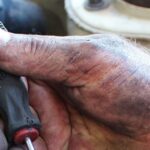Leather car seats, while luxurious and comfortable, are prone to wear and tear, especially in areas that see frequent use. Rips, tears, and holes can detract from your car’s interior aesthetics and value. Whether it’s a clean seam tear or a more challenging surface crack, addressing these issues promptly is key to preventing further damage and maintaining your car’s upholstery. This guide provides a practical approach to repairing ripped leather car upholstery, ensuring a lasting and visually appealing result.
Method 1: Repairing a Tear Through Leather Car Seat (Seam Tears)
Seam tears, often characterized by a clean separation along the stitching lines, are among the simpler leather repairs. This method utilizes a leather repair kit and a fabric patch to reinforce the tear from behind, providing a durable and discreet fix.
-
Prepare a Denim Patch: Cut a piece of denim fabric that is larger than the area of the tear. This patch will provide backing and strength to the repair.
-
Insert the Patch: Carefully insert the denim patch into the tear, positioning it centrally beneath the ripped area. Ensure the patch is adequately placed to cover the entire tear.
-
Apply Leather Adhesive: Dispense a small amount of leather adhesive into a disposable container. Using your fingertip, dip into the adhesive. Leather repair adhesives are designed to bond effectively with leather and fabric.
-
Adhere the Patch: Gently apply a thin layer of the leather adhesive to the denim patch within the tear. While applying, use your other hand to keep the tear slightly open for better access. If your car seat has perforated leather, be cautious not to use excessive adhesive that could seep through the holes.
-
Bond and Dry: Press the edges of the torn leather firmly onto the adhesive-coated denim patch. Hold in place for approximately 3 minutes to allow the adhesive to bond effectively. Ensure the leather edges align neatly for a seamless repair.
Method 2: Repairing Surface Damage and Cracked Leather Car Upholstery
Surface damage and cracked leather present a different challenge. These imperfections are often caused by wear, sun exposure, and the natural drying out of the leather. This method focuses on filling in the cracks and restoring the surface using a leather repair compound.
-
Apply Leather Repair Compound: Dispense a small amount of leather repair compound into a disposable bowl. Dip your finger into the compound and carefully apply it to fill in the cracks and surface tears. Ensure the compound penetrates into the low points of the damage.
-
Repeat Application (If Necessary): Depending on the depth and severity of the cracking, you may need to repeat step 1 multiple times. Allow each layer to dry before applying the next to ensure proper filling and reinforcement of the damaged area.
-
Smooth the Surface: Use a fine-grit emery board or a disposable nail file to gently sand away any excess dried repair compound. This step also helps to remove the shiny finish from the immediate area surrounding the repair. The goal is to create a smooth, matte surface that will allow the color finishing compound to adhere properly in the subsequent steps.
-
Clean and Prepare: Wipe the sanded area with an alcohol pad. This cleaning step is crucial for removing any dust and oils, ensuring optimal adhesion of the color finishing compound to the leather surface.
-
Mix Color Finishing Compound: Leather repair kits often include a set of color compounds. Mix a combination of these compounds (typically white, black, and brown) to create a custom color that perfectly matches your car seat’s leather. Start with small amounts and adjust gradually until you achieve a seamless color match.
-
Apply Color Compound: Using a plastic spatula or a similar applicator, apply a thin, even layer of the mixed color finishing compound over the repaired area. Allow it to dry completely.
-
Repeat and Texture (If Desired): Repeat step 6 until the repair is fully concealed and blends seamlessly with the surrounding leather. For a more natural leather look, you can gently blot the final coat of finishing compound with a sponge. This adds a subtle texture that can further help to match the original leather grain.
By following these steps, you can effectively repair ripped leather car upholstery, restoring the look and feel of your car’s interior. Regular maintenance and prompt attention to damage can further extend the life and beauty of your leather seats.

